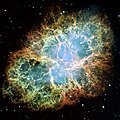File:Crab Nebula.jpg

本预览的尺寸:600 × 600像素。 其他分辨率:240 × 240像素 | 480 × 480像素 | 768 × 768像素 | 1,024 × 1,024像素 | 2,048 × 2,048像素 | 3,864 × 3,864像素。
原始文件 (3,864 × 3,864像素,文件大小:13.84 MB,MIME类型:image/jpeg)
文件历史
点击某个日期/时间查看对应时刻的文件。
| 日期/时间 | 缩略图 | 大小 | 用户 | 备注 | |
|---|---|---|---|---|---|
| 当前 | 2012年11月25日 (日) 14:56 |  | 3,864 × 3,864(13.84 MB) | Hawky.diddiz | Lossless optimization |
| 2012年5月17日 (四) 10:13 |  | 3,864 × 3,864(14.61 MB) | Metrónomo | Higher quality | |
| 2009年6月20日 (六) 09:31 |  | 3,864 × 3,864(6.18 MB) | Tryphon | Higher resolution. | |
| 2006年3月9日 (四) 21:26 |  | 2,224 × 2,212(3.08 MB) | Stianbh | larger version | |
| 2006年1月16日 (一) 00:35 |  | 400 × 400(23 KB) | DragonFire1024 | Image: A New View of the Helix Nebula Source: http://hubblesite.org/gallery/album/entire_collection/pr2004032d/ Copyright Notice: Material credited to STScI on this site was created, authored, and/or prepared for NASA under Contract NAS5-26555. Unless |
文件用途
超过100个页面使用本文件。 下面的列表只显示使用本文件的前100个页面。完整列表可用。
- SETI@home
- 三垣
- 中国天文学史
- 中子星
- 二十八宿
- 五車二
- 人马座
- 仙女座星系
- 伽利略衛星
- 冥王星
- 分子
- 北京古观象台
- 南十字座
- 历法
- 外层空间
- 天体测量学
- 天文学史
- 天文学家
- 天文學
- 天文現象
- 天王星的卫星
- 天體
- 太陽系外行星
- 夸克星
- 奥马尔·海亚姆
- 张衡
- 彗星
- 徐光启
- 恒星
- 新视野号
- 日冕
- 日食
- 星云
- 月相
- 月食
- 有机化合物
- 木卫二
- 木星的卫星
- 极光
- 氯化钠
- 海王星的卫星
- 祖冲之
- 米哈伊尔·罗蒙诺索夫
- 航天
- 蟹狀星雲
- 超新星
- 農曆
- 郭守敬
- 鄰近恆星列表
- 金星凌日
- 银河系
- 黑体辐射
- 黑洞
- 默冬章
- Talk:SETI@home
- Talk:万有引力常数
- Talk:世界
- Talk:乔瓦尼·多梅尼科·卡西尼
- Talk:人马座
- Talk:光球
- Talk:北京古观象台
- Talk:南回归线
- Talk:卡尔·萨根
- Talk:卡西尼-惠更斯号
- Talk:参考系
- Talk:埃拉托斯特尼
- Talk:大爆炸
- Talk:天文台
- Talk:天文學
- Talk:太阳系
- Talk:奥马尔·海亚姆
- Talk:宇宙
- Talk:小行星3388
- Talk:尼古拉·哥白尼
- Talk:开普勒定律
- Talk:弦理論
- Talk:恆星亮度列表
- Talk:方励之
- Talk:日食
- Talk:月食
- Talk:木卫五十八
- Talk:木星
- Talk:木星的卫星
- Talk:欧洲空间局
- Talk:沈括
- Talk:爱因斯坦场方程
- Talk:獵戶座
- Talk:相对论
- Talk:祖冲之
- Talk:艾萨克·牛顿
- Talk:行星
- Talk:诺贝尔物理学奖
- Talk:通古斯大爆炸
- Talk:量子力学
- Talk:金星凌日
- Talk:银河系
- Talk:黄历
- Talk:黑洞
- Template talk:太阳系
- Category:天体
查看连接到这个文件的更多链接。
全域文件用途
以下其他wiki使用此文件:
- af.wikipedia.org上的用途
- 1054
- Wikipedia:Uitgesoekte herdenkings/22 April
- Wikipedia:Uitgesoekte herdenkings/Julie
- Wikipedia:Uitgesoekte herdenkings/April
- Wikipedia:Uitgesoekte herdenkings/4 Julie
- Supernova
- Ster
- Wikipedia:Beeld van die week/2012
- Wikipedia:Voorbladbeeld week 2 2012
- Newel
- Kompakte ster
- Veranderlike ster
- Lys van Messier-voorwerpe
- Krapnewel
- Portaal:Sterrekunde/Inleiding
- Portaal:Sterrekunde
- Hemelliggaam
- Lys van planetêre newels
- SN 1054
- Supernova-oorblyfsel
- Sterevolusie
- als.wikipedia.org上的用途
- am.wikipedia.org上的用途
- anp.wikipedia.org上的用途
- ar.wikipedia.org上的用途
- مجرة
- نجم
- سنة
- تطور النجوم
- ثلاثي الكربون
- فجر
- مستعر أعظم
- بوابة:علم الفلك/مقالة مختارة
- شهاب
- مطلع مستقيم
- جمعية منسا الدولية
- علم الفلك خارج المجري
- عنقود نجمي
- فيلا (أقمار اصطناعية)
- الشلياق
- خرزات بيلي
- راية الأرض
- سمت
- نظرية الحالة الثابتة
- حياة الحيوان الكبرى
- توهج القمر الصناعي
- بوابة:الفيزياء/بوابات ذات علاقة
- بوابة:الفضاء
- الظهر
- اقتران (علم الفلك)
查看此文件的更多全域用途。

